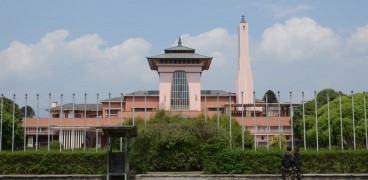Kanchenjunga Conservation Area is Nepal’s third protected area lying in the Himalayas in the eastern region. Part of the Sacred Himalayan Landscape it is named after Mt. Kanchenjunga (8,586 m), the third-highest mountain in the world.
The protected area lies within Taplejung district and is known for housing eleven mountain peaks whose elevation range above 7,000 m. Annapurna Region is also known as a Gift to the Earth, a title given by the Government of Nepal.
Location of Kanchenjunga Conservation Area
The conservation area is located in the eastern region of Nepal and lies within the Taplejung district. In the north, the protected area shares its international borders with Tibet’s Qomolangma National Nature Preserve and in the east with Sikkim’s Khangchendzonga National Park.

Map:Kangchenjunga Conservation Area
Credit:dnpc.com
In the west, it is bordered by the Sankhuwasabha district. The geographical coordinates of the conservation area are 27.7155°N 87.9282°E. The Kanchenjunga region covers an area of 2.035 sq km (786 sq mi) and ranges in altitude between 1,200 – 8,586 m.
The protected area is known for three major river valleys; Tamur River Valley, Ghunsa River Valley, and Simbuwa Khola Valley.
How to reach the Kanchenjunga Conservation Area?
You can catch a direct flight from Kathmandu to Suketar. Tourists who wish to travel by road must catch a bus from Kathmandu to Birtamode. From Birtamode you have to pass Ilam and Phidim along the way to reach Taplejung Bazaar finally.
The protected area can also be reached via bus from Dharan.
Entry Fees
Tourists from SAARC nations are required to pay a fee of NPR 200 while personnel from other foreign countries must pay NPR 2,000.
When is the best time to visit the Kanchenjunga Region?
The best suitable time to enjoy the Kanchenjunga Region is from February to May and between August and November.
Short History of Kanchenjunga Conservation Area
The Kanchenjunga region was designated as Nepal's third conservation area in the March of 1997. The Government of Nepal named the Kanchenjunga Region as a Gift to the Earth in April 1997.

Landscape view of Kanchenjunga
With the association of WWF Nepal, the Kanchenjunga Conservation Area Management Council was formed in April of 2003.
The council comprised of forty-four User Groups, thirty-two Mother Groups, and seven Conservation Area User Committees. The main objective of these committees was to see the proper implementation of the planned activities.
The Government of Nepal officially handed over the conservation and management of Kanchenjunga Conservation Area to the Management Council in August of 2006.
Vegetation of Kanchenjunga Region
The Kanchenchunga Conservation area is covered with thick forests, pastures, river, glaciers, high altitude lakes, and cultivated lands.
The vegetation of the area is classified into five major zones:
- Subtropical Evergreen Forest: this type of vegetation is found in the areas ranging between 800-1,200 m. The forests in these areas are covered with evergreen tree species like Castanopsis indica, engelhardtia spicata, and schima wallichii. However, a significant part of the forest is converted into agricultural land by the locals.
- Lower Temperate Forest: Better known as the Lower Temperate Mixed Broadleaf Forest, it lies between 1,200-2,500 m. This forest is dominated by broadleaf deciduous trees like rhododendron arboretum, Castanopsis, Quercus, and a few members of the laurel family. Trees of this kind shed their leaves during soring owing to drought stress.
- Upper Temperate Forest: This type of forest lies between 2,500-3,500 of altitude and is also called Temperate Cloud Forest and Upper Temperate Mixed Forest. In these types of the forest, there are deciduous trees like oaks, laurels, maples, and birches that are mixed with evergreen trees like magnolias, firs, rhododendrons, and junipers. The trees in this region are covered with epiphytic plants and mosses that grow due to heavy moisture in this zone.
- Sub-alpine Zone: The forest between 3,500 and 3,900 are covered mostly with evergreen conifers along with a few species of cold-hardy deciduous trees. The northern slopes belonging to this zone are covered with fir, juniper, birch, willow, and rhododendron while the southern side has dense stuned rhododendron forests. The Ghunsa Valley is covered with Himalayan larches (Larix griffithiana) that turn golden yellow during fall.
- Alpine Zone: The forests above 3,900-4,600 m are covered with roses, rhododendrons, gentian, saxifrange, and stuned junipers.
Wildlife found in Kanchenjunga Conservation Area
The rich forest of the Kanchenjunga serves as essential habitat for over 250 species of birds and several other species of endangered wildlife.

Kanchenjunga: Majestic Mountain Panorama
Credit:tigerencounter.com
The mammals found in the area are the rare Asian black bear, snow leopard, and Red panda. A leopard
a camera trap spotted cat in April 2012 at an elevation of 4,474 m.
In May 2012 a melanistic leopard was seen wandering at an altitude of 4,300 m. The region has also recorded the presence of yellow-throated marten in the alpine meadow at the height of 4,510 m (14,800 ft).
Things to do in Kanchenjunga Conservation Area
- Enjoy the spectacular view of mountains like Kangbachen (7,902 m), Kumbakarna (7,710 m), Gimmigela Chuli (7,350 m), and Drohmo Peak (6,881 m).
- Visit the Pathibhara Devi Temple
- Birdwatching
- Kanchenjunga Base Camp Trek
- Kanchenjunga North Base Camp Trek
- Kanchenjunga South Trek
- Milke Danda Trek
- Rafting and Kayaking in the Tamur/Arun river.
For more information on Conservation Areas present in Nepal, please visit Hopnepal.com.
















